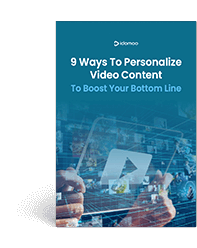In 1996, Bill Gates wrote an essay titled, “Content Is King,” coining a phrase that would be used for decades. Today, content’s rule over our lives is undeniable, with content marketing arising as an essential strategy for businesses. Unfortunately, with both businesses and consumers constantly creating content these days, the world has become dramatically noisier.
In this age of “infinite media,” most of us are experiencing content overload. With everything around us begging for attention, we’ve been forced to develop a sort of internal filter. Unless something is relevant to us in that particular moment in time, it’s often swiped away.
To break through the digital noise, marketers need to ensure that the messages and experiences they deliver are aligned with the customer’s immediate circumstances. In short, they need to shift from content marketing towards context marketing.
Even though context marketing is already on the rise, there’s still room to make it even better. Here’s everything you need to know about the power of context marketing, and how including video can make for an ever stronger strategy.
What Is Context Marketing?
Context marketing focuses on leveraging what you know about your audience in order to present content that speaks to their particular situation at a specific moment. Context adds that necessary dimension of value and meaning to the message or experience you’re delivering. This improves the chances that your target audience will engage with your brand.
In practice, this means finding opportunities to be genuinely helpful rather than just demanding attention without regard for the circumstances. According to Salesforce’s Director of Marketing Strategy, Mathew Sweezey, context marketing efforts should strive to include these 5 elements:
- Available: Provided to them when and how they want it.
- Permissioned: It’s better if they ask for it.
- Personal: How personalized is your delivery?
- Authentic: Empathy, tone, and consistency.
- Purposeful: The experience goes beyond the basic use of the product.
By crafting an interaction that fits a particular context, brands are showing consumers that they can be trusted to provide value with their communications. That trust is the foundation for improved engagement, greater demand, and, ultimately, a better bottom line.
A New Way To Approach Context Marketing
Most commonly, marketers approach context based marketing by concentrating on distribution. In other words, it’s about controlling how and where your content is shared in order to make sure it’s presented in the right circumstances.
Post on
Taco Bell, for instance, partnered with Waze to present special offers in-app, but only when drivers were actually near a Taco Bell location.
But there’s another approach that marketers can take. Rather than making sure your content is delivered in the right context, how about having your content evolve to match the context?
This is where Living Video comes in.
Video Becomes Contextual
Imagine a single piece of content that evolves in real time based on different user contexts, data or actions. What kind of content can do that? Text? An image? Sure — and now video can too.
By connecting to any live data feed, a single Living Video can have infinite variations, each one adapting to the circumstances in which its being presented with real-time accuracy.
When we talk about evolving videos, there’s a lot of examples to choose from. A contextual greeting like the one below includes constantly updated content. With Living Video, even the very structure of the video can change, presenting completely different scenes and content depending on the latest data.
For brands and organizations, Living Video can be an invaluable tool for powering context marketing efforts.
How exactly? We’ll get into that more below.
The Power of Context in Action
Living Video incorporates game-changing features such as in-player customization and interactivity (which both rely on user input and action), but its ability to draw from Living Data is especially relevant for context-based marketing.
The term refers to first- or third-party data feeds that affect the video content. Contextual data can range from a viewer’s current device to their current location.
Some possible use cases for Living Data include:
- A video connected to retail inventory to show what’s in stock or on sale, updating in real time based on product availability and pricing
- A shareable video that changes languages depending on where the viewer is located
- A travel recommendation that displays sunny getaways to anyone experiencing cold weather
- A restaurant promo video that showcases breakfast foods if watched in the morning and dinner dishes if seen in the evening
- An exclusive birthday offer with a timer that counts down to the big day
But that’s just a starting point. The possibilities are truly endless, and new data sources are being added all the time.
Video That Fits the Context
If content is king, then context is undoubtedly queen. To compare them to chess, content is the piece that’s needed to play the game, but context is what’s often behind the most powerful and effective moves.
At Idomoo, we’ve long subscribed to the idea that the one-size-fits-all approach is of the past. Today, the content, messages and experiences that brands deliver must be personalized and fit the context of each viewer’s circumstances. That’s why we developed a video platform that makes this all possible.
Our Next Generation Video Platform with Living Video functionalities has helped brands across industries quickly create data-driven, dynamic videos for their customers. Whether you have an audience of a few thousand or several million, our industry-leading platform is powerful enough to handle it all at scale.
Want to learn more? We’d love to show you exactly how we can revolutionize your context marketing strategies and help you reach your business goals.






